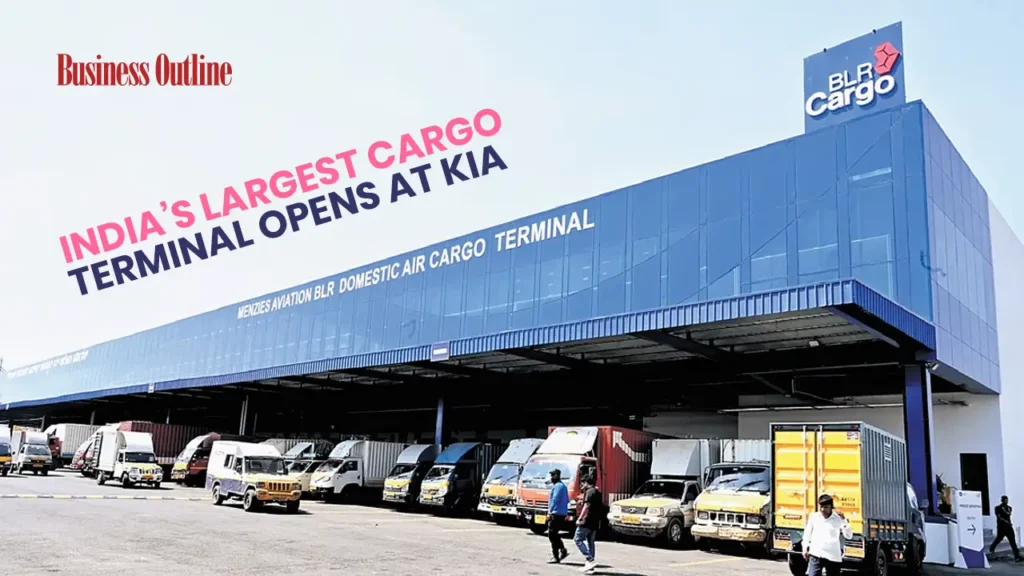Written by – Jaya pathak
The aviation sector of India has reached a new milestone on 27 February 2025. With the inauguration of India’s largest greenfield Domestic Cargo Terminal (DCT) at the Kempe Gowda International Airport, Bengaluru, this milestone has been achieved.
A joint initiative was taken by the Bangalore International Airport Limited (BIAL) and global ground handling giant Menzies Aviation. This facility marks a paradigm shift in India’s domestic air cargo infrastructure which promises to catalyse trade, streamline logistics and reinforce Bangalore’s standing as the premier cargo hub of India.
Opening Ceremony
The inauguration ceremony was held at Kempe Gowda International Airports cargo precinct and was presided over by the Chief Operating Officer of Bangalore International Airport limited Satyaki Raghunath alongside Charles Weyley who is the executive vice president in the Middle East, Africa and Asia at Menzies aviation.
While addressing the chief operating officer underlined the pivotal role Bengaluru will play in the cargo landscape of India. It handles around 13% of the national volumes and around 40% of South India’s air shipments. He expresses his confidence that the new terminal would drive the next decade of domestic cargo growth. The executive vice president Charles Wiley added that this facility was designed not only to meet today’s demand but to scale for future needs as the industry continues to evolve.
Capacity and scalability
It is spread over 7 acres. The new Domestic Cargo Terminal (DCT) boasts a built-up area of 245,000 square feet, 80% of which is dedicated to the core operational activities. It makes the largest Greenfield domestic cargo terminal by design capacity in India. The peak handling capacity stands at 360,000 metric tons per annum which can be expanded up to 400,000 metric tons as the cargo volumes grow. This capacity alone almost matches the entire current annual throughput of Bangalore and adds the critical buffer for future traffic surges.
Infrastructure
It comes with a cutting-edge infrastructure. The key features include 42 truck docks which can be used simultaneously for loading and unloading. Over 400 cargo bins can be used to organize and stage shipments. It comes with a conveyor system which is equipped with integrated X-ray machines which can be used for seamless security screening. It comes with a 30-unit load device build up and breakdown stations which can accelerate aircraft loading operations. It has 40 handheld scanning terminals and self-service kiosks Which can empower agents to manage manifests digitally and reducing paperwork induced delays.
Digital transformation and real time visibility
Beyond hardware, the terminal comes with software solution. It is equipped with real time shipment tracking dashboards, data analytical tools and bar code based communication systems. These software facilities are integrated with airline networks to ensure end to end visibility. This upgradation promises to turn around times, optimize warehouse workflows and enables predictive capacity planning which is a crucial step for perishable goods, pharmaceuticals and ecommerce consignments where time is money.
How Bangalore’s cargo ecosystem is strengthened?
The new DCT complements existing cargo operations at Kempe Gowda International Airport. It includes um 8 acre on airport logistics facility which is developed at a cost of rupees 200 crores. It offers truck parking, advanced truck management systems and direct linkage to cargo terminals to ensure swift last mile movements. It also includes joint ventures such as DHL blue darts 221,000 square feet perishable goods terminal and the earlier Menzies boba facility. It collectively handles the international and express cargo of the airport. These assets create a seamless cargo corridor positioning Bengaluru as a fulcrum for South India’s trade and manufacturing exports.
Economic and regional impact
- The manufacturers in Karnataka, karuna, Tamil Nadu and Andhra Pradesh will come across more reliable trade facilitation, opening new markets domestically.
- As the express delivery is gaining prominence, the terminals swift processing capabilities will empower online retailers to promise tighter delivery windows.
- It will generate employment. It requires cargo terminals Staffs, logistics service providers and ancillary trucking firms. It will create thousands of direct and indirect jobs.
- It will result in the regional development of Bengaluru including infrastructure, warehousing and integrated logistics parks around the city.
Sustainability
With regards to the environment and footprint, the Bangalore International Airport limited has designed the terminal with energy efficient LED lighting. Rainwater harvesting systems and zoned air conditioning to optimize power consumption. It provides airports truck management facility which can be developed in partnership with shell India which features driver rest launches, canteens and Wi-Fi, reflecting your commitment to welfare alongside operational excellence.
Future trends
With the new domestic cargo terminal operational, the Bangalore International Airport limited projects that by the end of this decade, Bangalore will be able to handle up to 1.5 million tons of cargo annually which is more than and its current volumes. The plans for expansion of runway capacity are already set.
Conclusion
The opening of India’s largest Greenfield domestic cargo terminal at the Kempe Gowda International Airport is not just an infrastructural achievement but it signifies A strategic investment in the trade and connectivity of the nation. With an incorporation of physical as well as digital capabilities, the Bangalore International Airport limited and Menzies aviation have adopted such a facility which not only addresses the challenges of today’s cargo but it has positioned itself to adapt to the demand of future. It will surely play a crucial role in sustaining India’s upward trajectory and global commerce
Read more: Top Business Magazine


